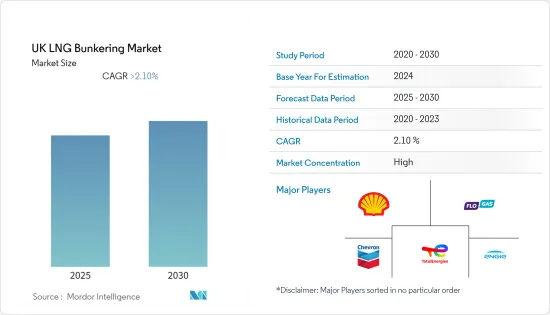 |
市場調查報告書
商品編碼
1630418
英國液化天然氣燃料庫:市場佔有率分析、產業趨勢、成長預測(2025-2030)UK LNG Bunkering - Market Share Analysis, Industry Trends & Statistics, Growth Forecasts (2025 - 2030) |
||||||
價格
※ 本網頁內容可能與最新版本有所差異。詳細情況請與我們聯繫。
簡介目錄
預計英國液化天然氣燃料庫市場在預測期內將維持超過2.1%的複合年成長率。

由於區域關閉和供應鏈中斷,COVID-19 大流行對市場產生了負面影響。目前,市場已達到疫情前水準。
主要亮點
- IMO 於 2020 年 1 月 1 日實施的 0.50% 燃料硫含量限制將改變船用燃料供應和可用性格局,推動英國液化天然氣燃料庫市場的發展。
- 然而,液化天然氣燃料庫基礎設施的缺乏可能會影響預測期內該國液化天然氣燃料庫活動的需求。
- 天然氣價格的下降已開始擴大未來幾年液化天然氣燃料庫活動的機會。
英國液化天然氣燃料庫市場趨勢
渡輪和 OSV 領域佔據市場主導地位
- 未來五年,使用LNG作為燃料的渡輪和OSV的數量預計將增加,因為使用LNG作為燃料的渡輪和OSV的訂單很多。在預測期內,對液化天然氣燃料庫服務的需求可能會增加。
- 英國政府計劃增加其在全球石油和天然氣產量中的佔有率,預計將提振市場。英國大陸棚(UKCS)地區預計將成為海運最活躍的近海地區之一。
- 2022年,英國本土石油和天然氣生產為英國GDP貢獻了約284億美元。英國政府預測,到2035年,該國能源結構的三分之二將是石油和天然氣。
- 此外,預測期內安排的各種石油和天然氣退役計劃可能會增加對 OSV 的需求,並預計將推動市場。
- 由於大部分的貿易是透過船舶進行的,而且船舶營運商使用液化天然氣燃料引擎,因此預計在預測期內,該國對液化天然氣燃料庫燃料需求將會增加。
石油和天然氣活動的成長推動市場
- 為了提供永續且環保的運輸網路,英國政府與各石油、天然氣和航運業者合作,推廣使用液化天然氣驅動的海上運輸。這將推動石油和天然氣行業的液化天然氣燃料庫市場。
- 推動石油和天然氣產業液化天然氣燃料庫市場的關鍵因素是航運業對液化天然氣減少二氧化碳排放的需求增加以及國內天然氣需求。此外,液化天然氣是一種更好的替代燃料,政府正在採取舉措來適應液化天然氣。
- 2021年天然氣產量約327億立方米,佔該地區約16%的產量佔有率。由於國家價格下降,未來幾年天然氣產量預計將增加。
- 根據貝克休斯統計,2023年3月海上鑽機數量為13座,超過2022年3月海上鑽機數量。這表明該國的石油和天然氣業務在海上比陸上更占主導地位。
- 這可能會激發石油和天然氣探勘與生產相關活動對船舶的需求,從而在預測期內提振目標市場。
英國液化天然氣燃料庫產業概況
英國液化天然氣燃料庫市場正在整合。市場主要企業包括(排名不分先後)Flogas Britain Ltd、Chevron Corporation、Engie SA、TotalEnergies SE 和 Shell PLC。
其他好處
- Excel 格式的市場預測 (ME) 表
- 3 個月分析師支持
目錄
第1章簡介
- 調查範圍
- 市場定義
- 研究場所
第 2 章執行摘要
第3章調查方法
第4章市場概況
- 介紹
- 至2028年市場規模及需求預測(單位:百萬美元)
- 最新趨勢和發展
- 政府法規和措施
- 市場動態
- 促進因素
- 抑制因素
- 供應鏈分析
- PESTLE分析
第5章 依最終用戶分類的市場區隔
- 油輪船隊
- 貨櫃船隊
- 散裝雜貨車隊
- 渡輪和 OSV
- 其他
第6章 競爭狀況
- 併購、合資、聯盟、協議
- 主要企業策略
- 公司簡介
- Engie SA
- Chevron corporation
- TotalEngeries SE
- Flogas Britain Ltd
- Shell PLC
第7章 市場機會及未來趨勢
簡介目錄
Product Code: 71256
The UK LNG Bunkering Market is expected to register a CAGR of greater than 2.1% during the forecast period.

The COVID-19 outbreak negatively impacted the market due to regional lockdowns and supply chain disruptions. Currently, the market reached pre-pandemic levels.
Key Highlights
- The bunker fuel supply and availability landscape changed when the IMO's regulation capping the global fuel Sulphur limit at 0.50% was enforced on 1 January 2020, likely driving the LNG bunkering market in the United Kingdom.
- However, the lack of LNG bunkering infrastructure will likely hurt the demand for LNG bunkering activities in the country during the forecast period.
- The reduced natural gas prices began expanding opportunities for LNG bunkering activities in the coming years.
UK LNG Bunkering Market Trends
Ferries and OSV Segment to Dominate the Market
- In the next five years, the LNG-based ferries and OSVs are projected to increase, considering the large number of LNG-fueled ferries and OSVs on order. It is likely to increase the demand for LNG bunkering services in the forecast period.
- The United Kingdom's government's plan to increase the country's global oil and gas production share is expected to boost the market. The United Kingdom Continental Shelf (UKCS) region is expected to become one of the most active offshore regions for maritime transport.
- Indigenous oil and gas production contributed around USD 28.4 billion to the United Kingdom's GDP in 2022. The UK government forecasts that two-thirds of the country's energy mix is expected to come from oil and gas by 2035.
- Additionally, various anticipated oil & gas decommissioning projects scheduled during the forecast period will likely increase the demand for OSVs, which is expected to drive the market.
- Since a major portion of the trade occurs through ships, and with the ship operators operating the LNG-fueled engines, the demand for LNG bunkering fuels is expected to increase in the country during the forecast period.
Growth in Oil & Gas Activities to Drive the Market
- To implement a sustainable and environmentally friendly transport network, the government of the United Kingdom, along with various oil and gas and shipping operators, promoted the use of LNG-powered marine transport. It will likely drive the LNG bunkering market in the oil & gas industry.
- The key factors driving the LNG bunkering market in the oil & gas industry are the increase in LNG demand to reduce carbon footprint in the shipping industry and the demand for natural gas in the country. Furthermore, LNG is a better alternative fuel, and the government is taking initiatives for LNG adaptation.
- The natural gas production in 2021 was about 32.7 billion cubic meters, providing around 16% production share to the region. Natural gas production is expected to rise in the coming years owing to the country's reduced price.
- According to Baker Hughes, the offshore rig count was 13 in March 2023, higher than the offshore rig count of March 2022. Thus indicating the dominancy of offshore oil and gas activities in the country over onshore.
- It calls for demand for ships in oil and gas E&P-related activities, likely to boost the target market over the forecast period.
UK LNG Bunkering Industry Overview
The United Kingdom LNG bunkering market is consolidated. Some of the key players in the market include (in no particular order) Flogas Britain Ltd, Chevron Corporation, Engie SA, TotalEnergies SE, and Shell PLC.
Additional Benefits:
- The market estimate (ME) sheet in Excel format
- 3 months of analyst support
TABLE OF CONTENTS
1 INTRODUCTION
- 1.1 Scope of the Study
- 1.2 Market Definition
- 1.3 Study Assumptions
2 EXECUTIVE SUMMARY
3 RESEARCH METHODOLOGY
4 MARKET OVERVIEW
- 4.1 Introduction
- 4.2 Market Size and Demand Forecast in USD million, till 2028
- 4.3 Recent Trends and Developments
- 4.4 Government Policies and Regulations
- 4.5 Market Dynamics
- 4.5.1 Drivers
- 4.5.2 Restraints
- 4.6 Supply Chain Analysis
- 4.7 PESTLE Analysis
5 MARKET SEGMENTATIONBY END-USER
- 5.1 Tanker Fleet
- 5.2 Container Fleet
- 5.3 Bulk and General Cargo Fleet
- 5.4 Ferries and OSV
- 5.5 Others
6 COMPETITIVE LANDSCAPE
- 6.1 Mergers and Acquisitions, Joint Ventures, Collaborations, and Agreements
- 6.2 Strategies Adopted by Leading Players
- 6.3 Company Profiles
- 6.3.1 Engie SA
- 6.3.2 Chevron corporation
- 6.3.3 TotalEngeries SE
- 6.3.4 Flogas Britain Ltd
- 6.3.5 Shell PLC
7 MARKET OPPORTUNITIES AND FUTURE TRENDS
02-2729-4219
+886-2-2729-4219













